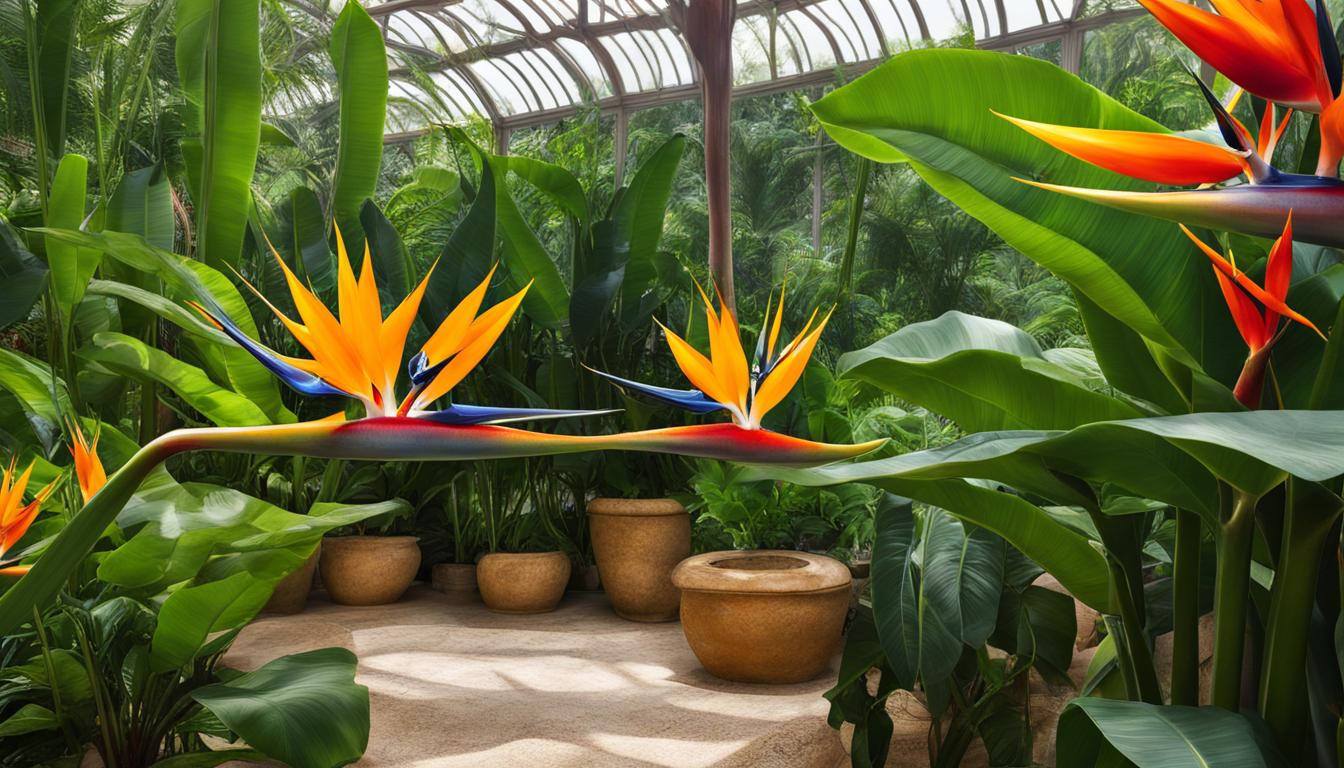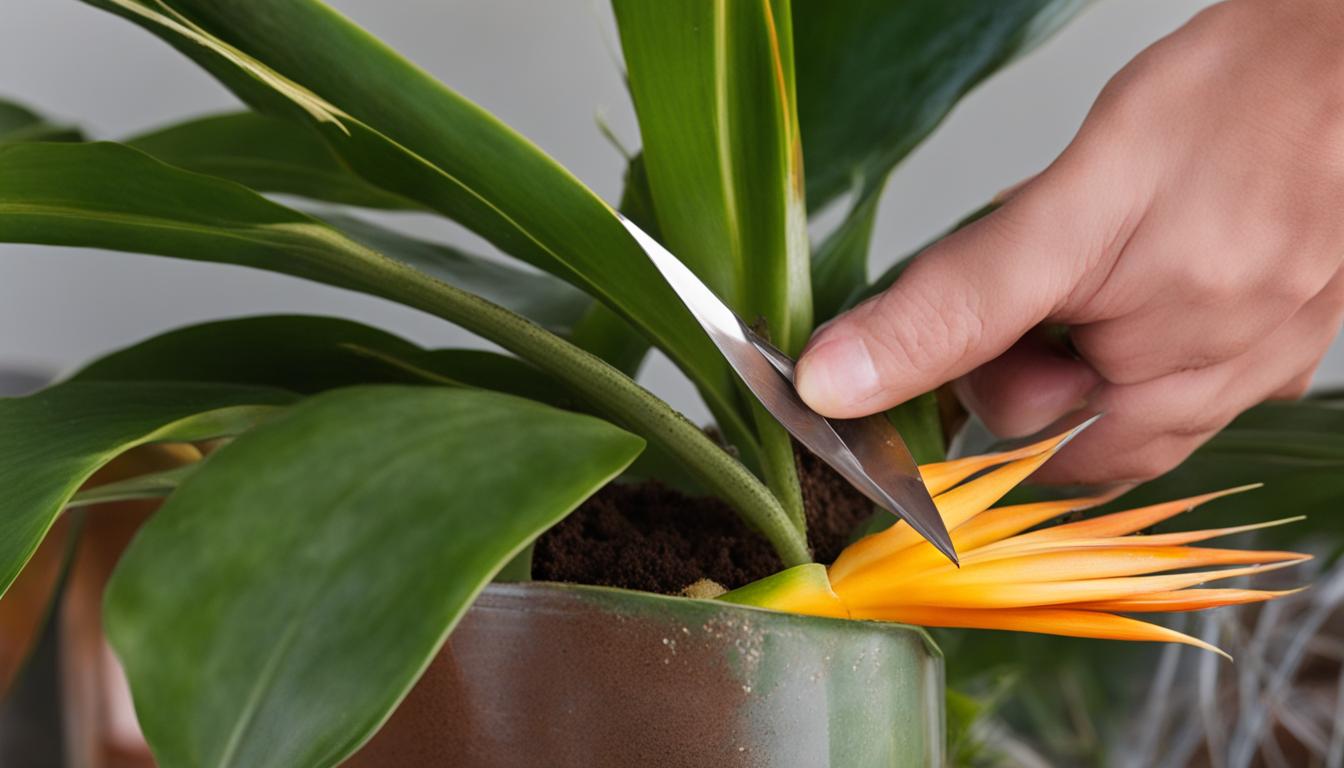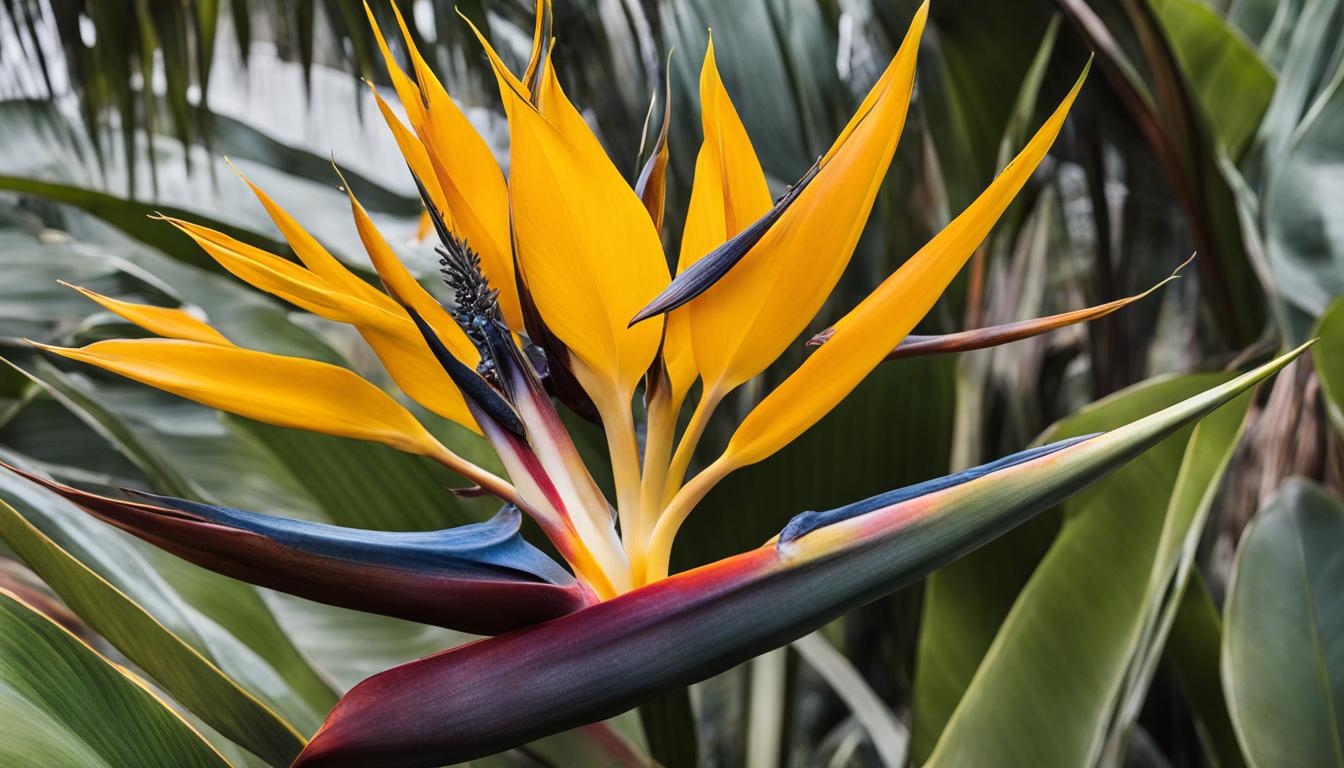Welcome to my Bird of Paradise Care Guide! If you’re looking to add a touch of tropical elegance to your space, the Bird of Paradise (Strelitzia reginae) is the perfect plant for you. With its vibrant orange crane-like flowers and lush green foliage, this regal plant is sure to make a statement.
Often mistaken for a banana tree, the Bird of Paradise is native to South Africa and thrives in warm, tropical climates. While it may be challenging to cultivate this plant indoors, with the right care, it can blossom beautifully even in your home.
In this guide, I’ll walk you through everything you need to know about caring for your Bird of Paradise. From sunlight and watering requirements to humidity, temperature, and common problems, you’ll learn how to provide the ideal conditions for your plant to flourish.
So, let’s dive in and discover the secrets to keeping your Bird of Paradise happy and thriving!
Sunlight and Water Requirements for Bird of Paradise
The Bird of Paradise plant requires specific care when it comes to sunlight and watering. To ensure the health and vitality of your Bird of Paradise, it’s important to provide it with the right amount of light and water. Let’s explore the sunlight and water requirements in detail.
Sunlight:
The Bird of Paradise thrives in bright indirect light to full sun when acclimated. It is not suited for low light conditions. This means that placing your Bird of Paradise near a south-facing window where it can receive at least 6 hours of sunlight per day is ideal. If you don’t have access to direct sunlight, consider using grow lights to provide the necessary light intensity.
Watering:
The Bird of Paradise plant requires regular watering, allowing the soil to dry out between waterings. The frequency of watering may vary depending on the light levels, humidity, and temperature. As a general guideline, water your Bird of Paradise every 1-2 weeks, checking the moisture level of the soil before watering again. It’s important not to overwater the plant, as this can lead to root rot. Use your finger to test the soil moisture, and only water when the top 1-2 inches of the soil are dry.
| Signs of Underwatering: | Signs of Overwatering: |
|---|---|
| – Wilting leaves | – Yellowing leaves |
| – Dry soil | – Root rot |
| – Curling leaves | – Fungus or mold growth |
Remember to use filtered water or let the water sit out overnight before using it for your Bird of Paradise. This helps remove chemicals such as chlorine, which can be harmful to the plant. By providing the right amount of sunlight and water, you can ensure your Bird of Paradise thrives and brings beauty to your home.
The Importance of Humidity and Temperature for Bird of Paradise
When it comes to caring for your Bird of Paradise, humidity and temperature play crucial roles in ensuring its health and well-being. While this tropical plant can tolerate normal room humidity, it thrives in humid conditions. Higher humidity levels can be achieved by using a fine-mist mister or humidifier to create a more tropical environment for your plant.
In addition to humidity, maintaining the right temperature is equally important. Bird of Paradise plants prefer temperatures in the range of 65°F-85°F (18°C-30°C). It’s important to avoid subjecting the plant to temperatures below 60°F (15°C), as this can cause stress and hinder its growth.
To create the ideal environment for your Bird of Paradise, consider placing it in a bathroom or near a humidifier. This will provide the necessary moisture in the air to mimic its natural habitat. Additionally, ensure that the plant is not exposed to drafts or extreme temperature fluctuations, as this can also negatively impact its overall health.
Why is Humidity and Temperature Important?
Bird of Paradise plants are native to tropical regions and require higher humidity levels to thrive. Adequate humidity helps maintain the plant’s overall health by preventing issues such as dry and crispy leaves. Without sufficient humidity, the plant may develop brown tips or edges on its leaves, indicating a need for increased moisture in the air.
Temperature is equally vital to the plant’s well-being. Bird of Paradise plants are sensitive to cold temperatures and can suffer damage if exposed to prolonged periods of low temperatures. By providing the plant with the ideal temperature range, you can ensure that it remains healthy and continues to grow vigorously.
| Humidity | Temperature |
|---|---|
| Higher humidity levels mimic the plant’s natural habitat and promote vibrant growth. | Temperatures between 65°F-85°F (18°C-30°C) create the ideal conditions for the plant to thrive. |
| Inadequate humidity can lead to dry and crispy leaves. | Temperatures below 60°F (15°C) can cause stress and hinder the plant’s growth. |
| A fine-mist mister or humidifier can help increase humidity levels. | Keep the plant away from drafts and extreme temperature fluctuations. |
Bird of Paradise Soil and Common Problems
When it comes to caring for your Bird of Paradise, having the right soil is crucial. This plant thrives in well-draining potting mix, which allows excess water to flow out and prevents root rot. You can improve soil drainage by adding ingredients like perlite or lava rocks to the mix. These help increase aeration and ensure the roots have enough oxygen.
While Bird of Paradise is generally a hardy plant, it can face a few common problems. One issue you might notice is splits along the sides of leaves. Don’t worry, this is a normal adaptation that helps the plant withstand strong winds. Another problem to watch out for is yellowing lower leaves, which can be a sign of overwatering. It’s important to let the soil dry out between waterings to avoid excessive moisture. On the other hand, wilting and curling leaves can indicate underwatering. Make sure to water your Bird of Paradise regularly, especially during hotter months, and adjust the frequency based on the plant’s needs.
Pests can also affect your Bird of Paradise, with spider mites being a common concern. Spider mites are tiny insects that can cause damage by sucking on the plant’s sap. To combat these pests, you can use natural remedies like neem oil sprays or wipe the leaves regularly with a damp cloth. By keeping an eye on your Bird of Paradise’s soil and addressing any issues promptly, you can help ensure that your plant stays healthy and vibrant.
| Common Problems | Cause | Solution |
|---|---|---|
| Splits along the sides of leaves | Adaptive precaution to withstand strong winds | No action needed, it’s natural |
| Yellowing lower leaves | Overwatering | Allow soil to dry between waterings |
| Wilting and curling leaves | Underwatering | Water the plant regularly, adjusting frequency as needed |
| Spider mites | Pest infestation | Use neem oil sprays and wipe leaves regularly |
Remember, caring for your Bird of Paradise means paying attention to its soil and addressing common problems promptly. By providing the right conditions and keeping a watchful eye, you can enjoy the beauty and elegance of this tropical plant in your home.

Conclusion
The Bird of Paradise is a stunning tropical plant that can bring a vibrant touch to any space. By providing the right conditions and care, you can ensure that your Bird of Paradise thrives and stays healthy.
To keep your Bird of Paradise happy, make sure it gets bright indirect light or full sun exposure. This plant also requires well-draining soil, so adding ingredients like perlite or lava rocks can help improve soil aeration.
Regular watering is important for the Bird of Paradise, but be sure to allow the soil to dry out between waterings to prevent overwatering. It is also recommended to use filtered water or let tap water sit out overnight to avoid any potential harm from chemicals.
Keep an eye out for common problems like yellowing lower leaves (a sign of overwatering) or wilting and curling leaves (indicating underwatering). Pests like spider mites might appear, but you can treat them with natural pesticides like neem oil and by regularly wiping the leaves.
Remember, the Bird of Paradise is toxic to cats, dogs, and humans if ingested. So, be sure to keep it out of reach of children and pets to ensure their safety.
In conclusion, by following these Bird of Paradise care tips and providing the right conditions, you can enjoy the beauty of this plant and create a thriving environment for it in your home.
FAQ
Can Bird of Paradise flower indoors?
Yes, Bird of Paradise can flower indoors under the right conditions of full, southern light exposure, proper humidity, and temperature.
How often should I water my Bird of Paradise?
Water your Bird of Paradise every 1-2 weeks, allowing the soil to dry out between waterings. The frequency may vary depending on light levels.
Does Bird of Paradise require high humidity?
While Bird of Paradise can tolerate normal room humidity, it prefers humid conditions if possible. Consider using a misting mister or humidifier to boost humidity indoors.
What temperature range does Bird of Paradise prefer?
Bird of Paradise prefers temperatures between 65°F-85°F (18°C-30°C) and should not be subjected to temperatures below 60°F (15°C).
What type of soil does Bird of Paradise need?
Bird of Paradise requires a well-draining potting mix. You can mix in ingredients like perlite or lava rocks to increase soil aeration if needed.
How do I treat spider mites on my Bird of Paradise?
Spider mites can be treated with weekly sprays of natural pesticide, like neem oil, and regular wiping of the leaves.
Why do the leaves of my Bird of Paradise have splits along the sides?
Splits along the sides of leaves are a normal adaptive precaution to help the plant bear strong winds.
What should I do if the lower leaves of my Bird of Paradise turn yellow?
Yellowing lower leaves are usually caused by overwatering. Adjust your watering schedule accordingly.
Why are the leaves of my Bird of Paradise wilting and curling?
Wilting and curling leaves are usually caused by underwatering. Make sure to water your plant regularly and adjust as needed.
Is Bird of Paradise toxic to pets and humans?
Yes, Bird of Paradise can be toxic if ingested by cats, dogs, and humans. Keep it out of reach of children and pets.



